兴奋剂检测
- 格式:ppt
- 大小:78.50 KB
- 文档页数:20
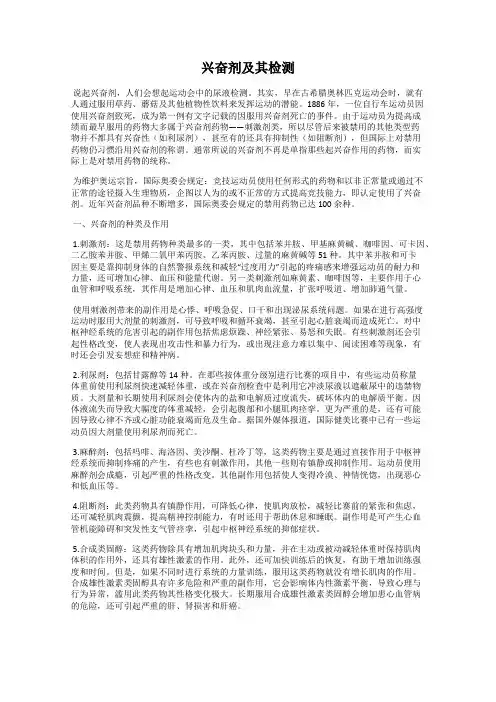
兴奋剂及其检测说起兴奋剂,人们会想起运动会中的尿液检测。
其实,早在古希腊奥林匹克运动会时,就有人通过服用草药、蘑菇及其他植物性饮料来发挥运动的潜能。
1886年,一位自行车运动员因使用兴奋剂致死,成为第一例有文字记载的因服用兴奋剂死亡的事件。
由于运动员为提高成绩而最早服用的药物大多属于兴奋剂药物——刺激剂类,所以尽管后来被禁用的其他类型药物并不都具有兴奋性(如利尿剂),甚至有的还具有抑制性(如阻断剂),但国际上对禁用药物仍习惯沿用兴奋剂的称谓。
通常所说的兴奋剂不再是单指那些起兴奋作用的药物,而实际上是对禁用药物的统称。
为维护奥运宗旨,国际奥委会规定:竞技运动员使用任何形式的药物和以非正常量或通过不正常的途径摄入生理物质,企图以人为的或不正常的方式提高竞技能力,即认定使用了兴奋剂。
近年兴奋剂品种不断增多,国际奥委会规定的禁用药物已达100 余种。
一、兴奋剂的种类及作用1.刺激剂:这是禁用药物种类最多的一类,其中包括苯并胺、甲基麻黄碱、咖啡因、可卡因、二乙胺苯并胺、甲烯二氧甲苯丙胺、乙苯丙胺、过量的麻黄碱等51种。
其中苯并胺和可卡因主要是靠抑制身体的自然警报系统和减轻“过度用力”引起的疼痛感来增强运动员的耐力和力量,还可增加心律、血压和能量代谢。
另一类刺激剂如麻黄素、咖啡因等,主要作用于心血管和呼吸系统,其作用是增加心律、血压和肌肉血流量,扩张呼吸道、增加肺通气量。
使用刺激剂带来的副作用是心悸、呼吸急促、口干和出现泌尿系统问题。
如果在进行高强度运动时服用大剂量的刺激剂,可导致呼吸和循环衰竭,甚至引起心脏衰竭而造成死亡。
对中枢神经系统的危害引起的副作用包括焦虑烦躁、神经紧张、易怒和失眠。
有些刺激剂还会引起性格改变,使人表现出攻击性和暴力行为,或出现注意力难以集中、阅读困难等现象,有时还会引发妄想症和精神病。
2.利尿剂:包括甘露醇等14种。
在那些按体重分级别进行比赛的项目中,有些运动员称量体重前使用利尿剂快速减轻体重,或在兴奋剂检查中是利用它冲淡尿液以遮蔽尿中的违禁物质。
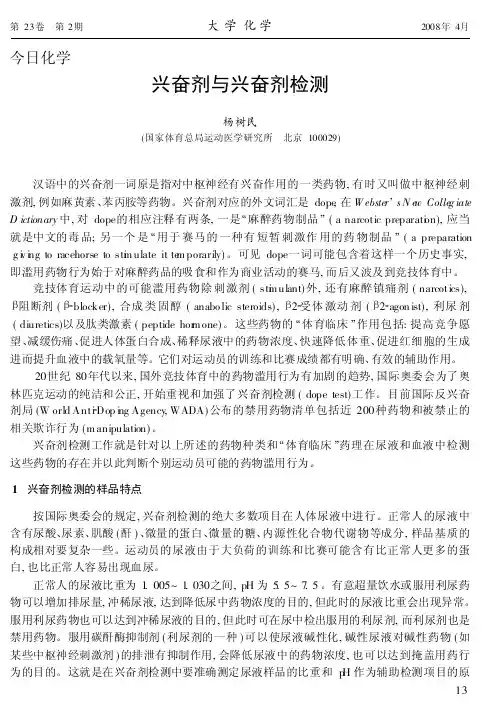
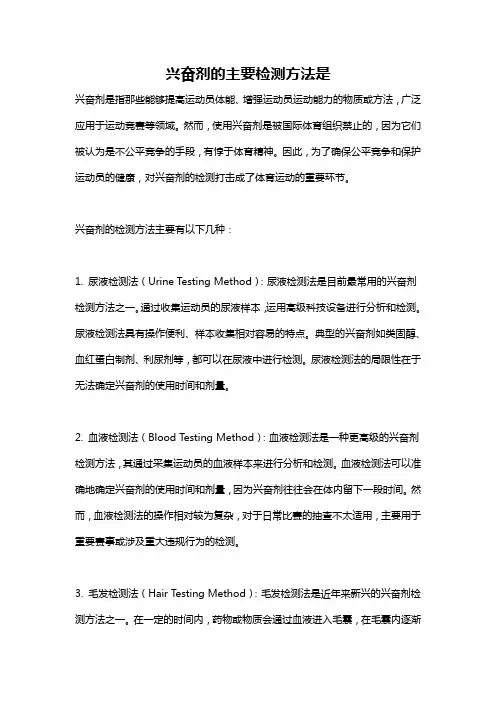
兴奋剂的主要检测方法是兴奋剂是指那些能够提高运动员体能、增强运动员运动能力的物质或方法,广泛应用于运动竞赛等领域。
然而,使用兴奋剂是被国际体育组织禁止的,因为它们被认为是不公平竞争的手段,有悖于体育精神。
因此,为了确保公平竞争和保护运动员的健康,对兴奋剂的检测打击成了体育运动的重要环节。
兴奋剂的检测方法主要有以下几种:1. 尿液检测法(Urine Testing Method):尿液检测法是目前最常用的兴奋剂检测方法之一。
通过收集运动员的尿液样本,运用高级科技设备进行分析和检测。
尿液检测法具有操作便利、样本收集相对容易的特点。
典型的兴奋剂如类固醇、血红蛋白制剂、利尿剂等,都可以在尿液中进行检测。
尿液检测法的局限性在于无法确定兴奋剂的使用时间和剂量。
2. 血液检测法(Blood Testing Method):血液检测法是一种更高级的兴奋剂检测方法,其通过采集运动员的血液样本来进行分析和检测。
血液检测法可以准确地确定兴奋剂的使用时间和剂量,因为兴奋剂往往会在体内留下一段时间。
然而,血液检测法的操作相对较为复杂,对于日常比赛的抽查不太适用,主要用于重要赛事或涉及重大违规行为的检测。
3. 毛发检测法(Hair Testing Method):毛发检测法是近年来新兴的兴奋剂检测方法之一。
在一定的时间内,药物或物质会通过血液进入毛囊,在毛囊内逐渐沉积。
毛发检测法可以通过采集运动员的毛发样本来进行分析和检测,以此识别是否存在兴奋剂的使用。
毛发检测法的优势在于可以追踪长达数月的兴奋剂使用情况,具有较高的准确性和可靠性。
4. 尿液碳同位素比检测法(Carbon Isotope Ratio Testing Method):尿液碳同位素比检测法是一种新兴的兴奋剂检测方法,主要用于检测合成类固醇的使用。
该方法通过分析尿液中同位素比例的变化来判断是否存在兴奋剂的使用。
兴奋剂中的碳同位素比例与人体自然合成的物质不同,因此可以通过比例的差异来确定是否存在兴奋剂的使用。

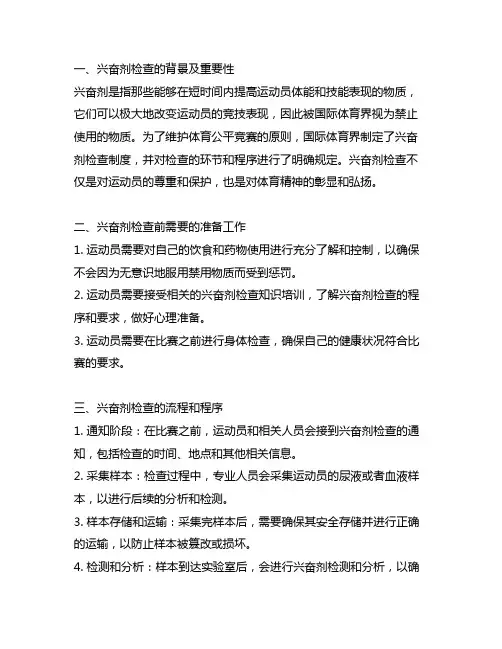
一、兴奋剂检查的背景及重要性兴奋剂是指那些能够在短时间内提高运动员体能和技能表现的物质,它们可以极大地改变运动员的竞技表现,因此被国际体育界视为禁止使用的物质。
为了维护体育公平竞赛的原则,国际体育界制定了兴奋剂检查制度,并对检查的环节和程序进行了明确规定。
兴奋剂检查不仅是对运动员的尊重和保护,也是对体育精神的彰显和弘扬。
二、兴奋剂检查前需要的准备工作1. 运动员需要对自己的饮食和药物使用进行充分了解和控制,以确保不会因为无意识地服用禁用物质而受到惩罚。
2. 运动员需要接受相关的兴奋剂检查知识培训,了解兴奋剂检查的程序和要求,做好心理准备。
3. 运动员需要在比赛之前进行身体检查,确保自己的健康状况符合比赛的要求。
三、兴奋剂检查的流程和程序1. 通知阶段:在比赛之前,运动员和相关人员会接到兴奋剂检查的通知,包括检查的时间、地点和其他相关信息。
2. 采集样本:检查过程中,专业人员会采集运动员的尿液或者血液样本,以进行后续的分析和检测。
3. 样本存储和运输:采集完样本后,需要确保其安全存储并进行正确的运输,以防止样本被篡改或损坏。
4. 检测和分析:样本到达实验室后,会进行兴奋剂检测和分析,以确定是否存在禁用物质的使用。
5. 报告和处理:检测结果会通知相关的体育组织和运动员本人,如果检测结果呈阳性,将会进行相关的处理和处罚。
四、兴奋剂检查中需要注意的事项1. 合理使用药物:运动员在使用药物时需要交流专业医生,确保所用药物不含有禁用物质。
2. 遵守检查程序:运动员需要严格遵守兴奋剂检查的程序和要求,配合检查人员的工作,避免因为违规行为而受到处罚。
3. 注意饮食安全:饮食不良可能导致食品中存在禁用物质,因此需要谨慎选择食品来源和饮食方式。
4. 提高兴奋剂意识:运动员和相关人员需要加强对兴奋剂的认识和了解,做到知法懂法,避免因为无知而受到不公正的对待。
5. 改善监督体系:体育组织和相关部门需要加强对兴奋剂检查工作的监督和管理,建立完善的检查制度和流程,确保检查工作的公正和透明。
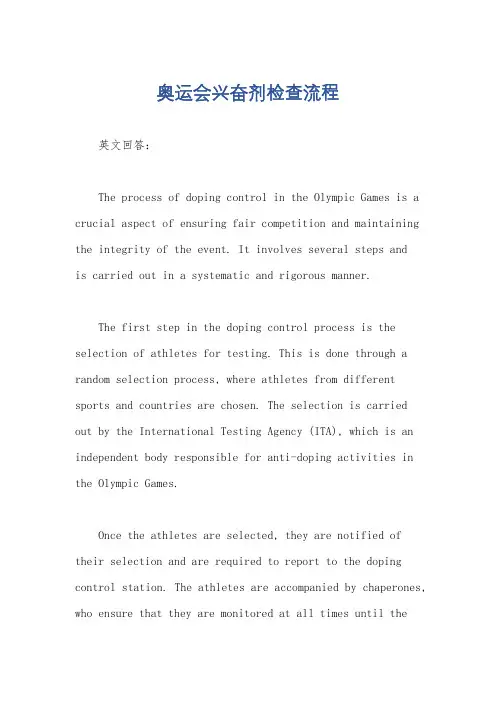
奥运会兴奋剂检查流程英文回答:The process of doping control in the Olympic Games is a crucial aspect of ensuring fair competition and maintaining the integrity of the event. It involves several steps andis carried out in a systematic and rigorous manner.The first step in the doping control process is the selection of athletes for testing. This is done through a random selection process, where athletes from different sports and countries are chosen. The selection is carriedout by the International Testing Agency (ITA), which is an independent body responsible for anti-doping activities in the Olympic Games.Once the athletes are selected, they are notified of their selection and are required to report to the doping control station. The athletes are accompanied by chaperones, who ensure that they are monitored at all times until thecompletion of the testing process.At the doping control station, the athletes are required to provide a urine sample under the supervision of a Doping Control Officer (DCO) or a trained chaperone of the same gender. The athletes are also required to provide a blood sample, which is collected by a qualified medical professional. These samples are collected in specially designed kits that ensure the integrity and security of the samples.After the samples are collected, they are sealed and labeled with a unique identification number. The athletes are also required to complete a Doping Control Form, which includes information about any medications or supplements they have taken recently.The samples are then transported to a World Anti-Doping Agency (WADA) accredited laboratory for analysis. At the laboratory, the samples undergo a series of tests to detect the presence of prohibited substances or their metabolites. The laboratory follows strict quality control procedures toensure accurate and reliable results.The analysis of the samples is carried out by highly trained scientists using state-of-the-art equipment and techniques. The laboratory follows a two-step process, where the initial screening test is followed by a confirmatory test for any positive or suspicious results. The laboratory reports the results to the ITA, who then notifies the athletes and their respective National Olympic Committees (NOCs).If an athlete's sample tests positive for a prohibited substance, they have the right to request the analysis of the B sample, which is the second sample collected at the time of testing. If the B sample also tests positive, the athlete may face disciplinary action, including disqualification from the Olympic Games and sanctions from their respective sports federations.Overall, the doping control process in the Olympic Games is designed to be thorough and comprehensive. It involves multiple steps, from athlete selection to samplecollection and analysis. The process is carried out by independent and accredited bodies to ensure fairness and integrity in sports.中文回答:奥运会兴奋剂检查流程是确保公平竞争和维护比赛的诚信的重要环节。
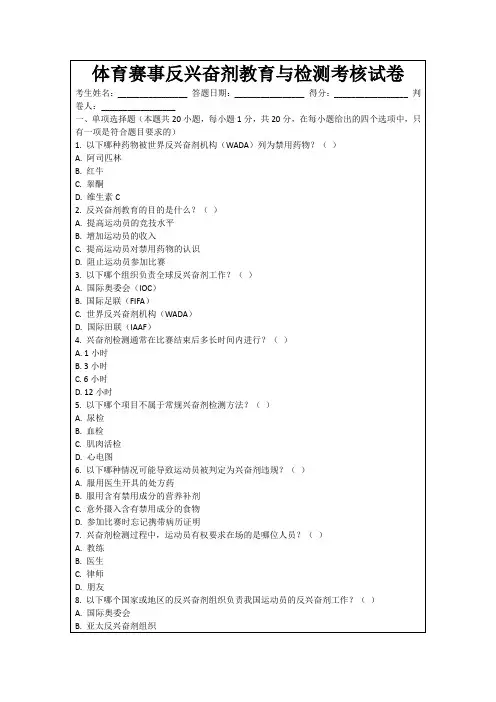
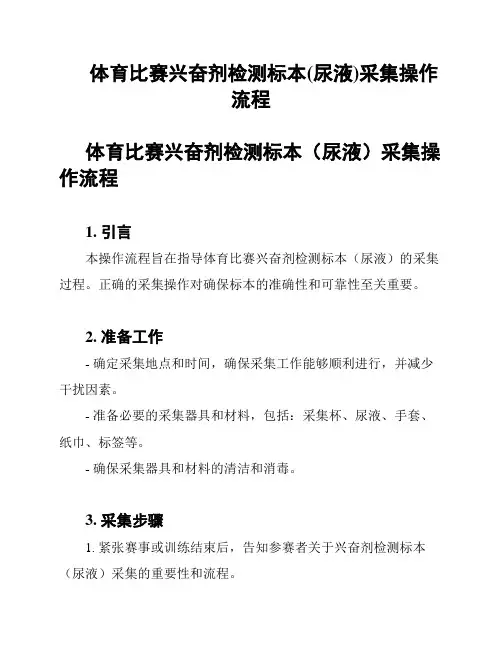
体育比赛兴奋剂检测标本(尿液)采集操作流程体育比赛兴奋剂检测标本(尿液)采集操作流程1. 引言本操作流程旨在指导体育比赛兴奋剂检测标本(尿液)的采集过程。
正确的采集操作对确保标本的准确性和可靠性至关重要。
2. 准备工作- 确定采集地点和时间,确保采集工作能够顺利进行,并减少干扰因素。
- 准备必要的采集器具和材料,包括:采集杯、尿液、手套、纸巾、标签等。
- 确保采集器具和材料的清洁和消毒。
3. 采集步骤1. 紧张赛事或训练结束后,告知参赛者关于兴奋剂检测标本(尿液)采集的重要性和流程。
2. 给予参赛者足够时间饮水,以促进尿液的产生。
3. 在指定的采集地点,提供隐私并确保参赛者能够舒适地进行采集。
4. 参赛者佩戴手套后,用清洁的纸巾清洁外生殖器区域,并将采集杯递给参赛者。
5. 参赛者将采集杯放置在水平位置,采集第一次小便的前部分,然后继续采集中间部分和尾部分,直至尿液采集完毕。
6. 参赛者将采集好的尿液转移到尿液中,并紧闭盖子。
7. 标签上写明参赛者的姓名、日期、时间等信息,并粘贴在尿液上。
8. 清理采集地点,将采集器具和材料进行妥善处理。
9. 将尿液标本送至指定的检测实验室。
4. 注意事项- 保持整个采集过程的隐私和机密性,确保参赛者的尊重和尊严。
- 严格遵守规定的卫生和消毒标准,以确保标本的纯净和可靠性。
- 标本在采集后应尽快送达检测实验室,避免延误和污染。
- 涉及到兴奋剂检测标本采集的相关法律规定和条款请遵守,并咨询相关专业人士或机构的意见。
以上为体育比赛兴奋剂检测标本(尿液)采集的操作流程,请根据实际情况进行操作,并始终保持准确、可靠和合法的原则。
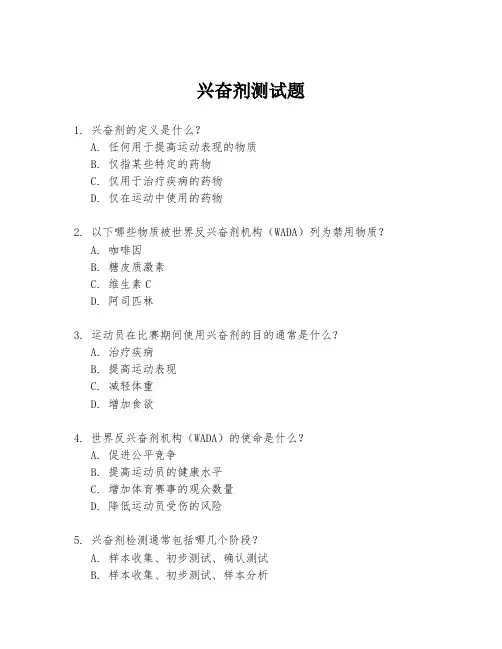
兴奋剂测试题1. 兴奋剂的定义是什么?A. 任何用于提高运动表现的物质B. 仅指某些特定的药物C. 仅用于治疗疾病的药物D. 仅在运动中使用的药物2. 以下哪些物质被世界反兴奋剂机构(WADA)列为禁用物质?A. 咖啡因B. 糖皮质激素C. 维生素CD. 阿司匹林3. 运动员在比赛期间使用兴奋剂的目的通常是什么?A. 治疗疾病B. 提高运动表现C. 减轻体重D. 增加食欲4. 世界反兴奋剂机构(WADA)的使命是什么?A. 促进公平竞争B. 提高运动员的健康水平C. 增加体育赛事的观众数量D. 降低运动员受伤的风险5. 兴奋剂检测通常包括哪几个阶段?A. 样本收集、初步测试、确认测试B. 样本收集、初步测试、样本分析C. 样本分析、初步测试、确认测试D. 样本分析、样本收集、确认测试6. 运动员在接受兴奋剂检测时,以下哪些行为是被禁止的?A. 拒绝提供样本B. 延迟提供样本C. 提供虚假信息D. 所有上述行为7. 运动员如果被检测出使用兴奋剂,可能面临哪些后果?A. 警告B. 罚款C. 禁赛D. 所有上述后果8. 以下哪些因素可能影响兴奋剂检测的准确性?A. 样本的储存条件B. 检测方法的选择C. 样本的采集时间D. 所有上述因素9. 运动员在比赛前使用含有兴奋剂的药品,以下哪些情况可以作为免除责任的辩护?A. 运动员有医生的处方B. 运动员不知情C. 药品是治疗运动员的疾病所必需的D. 所有上述情况10. 兴奋剂检测的样本通常包括哪些类型?A. 血液B. 尿液C. 唾液D. 所有上述类型正确答案:1. A2. B3. B4. A5. A6. D7. D8. D9. D10. D。
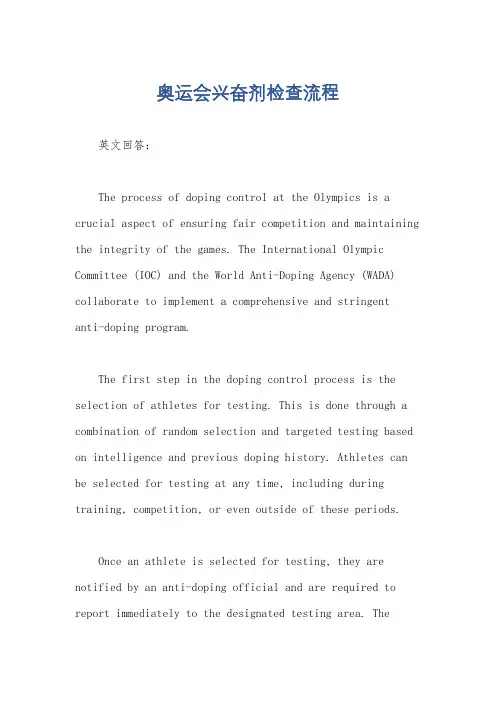
奥运会兴奋剂检查流程英文回答:The process of doping control at the Olympics is a crucial aspect of ensuring fair competition and maintaining the integrity of the games. The International Olympic Committee (IOC) and the World Anti-Doping Agency (WADA) collaborate to implement a comprehensive and stringentanti-doping program.The first step in the doping control process is the selection of athletes for testing. This is done through a combination of random selection and targeted testing based on intelligence and previous doping history. Athletes can be selected for testing at any time, including during training, competition, or even outside of these periods.Once an athlete is selected for testing, they are notified by an anti-doping official and are required to report immediately to the designated testing area. Theathlete's identification is verified, and they are accompanied by a chaperone to ensure the integrity of the sample collection process.In the testing area, the athlete is required to provide a urine sample under the observation of a same-sex chaperone. The chaperone ensures that the athlete follows the proper procedures and that the sample is not tampered with. Additionally, blood samples may also be collected in certain cases, especially for substances that are noteasily detectable in urine.After providing the sample, the athlete is required to complete a doping control form, providing information about any medications or supplements they have taken recently. This information is crucial for the evaluation of the test results and to determine if any prohibited substances were used.The collected samples are then securely sealed and transported to a WADA-accredited laboratory for analysis. The laboratories use state-of-the-art equipment andtechniques to detect the presence of prohibited substancesin the samples. The analysis includes both initialscreening tests and confirmatory tests to ensure accurate and reliable results.If the analysis confirms the presence of a prohibited substance, the athlete is notified and given an opportunity to provide an explanation. They may request the analysis of the B-sample, which is an additional sample collected atthe same time as the A-sample, to confirm or refute the initial findings. If the B-sample also confirms the presence of a prohibited substance, the athlete may face disciplinary action, including disqualification, suspension, or even a lifetime ban from participating in the Olympics.中文回答:奥运会兴奋剂检查流程是确保比赛公平竞争和维护比赛的诚信的关键环节。
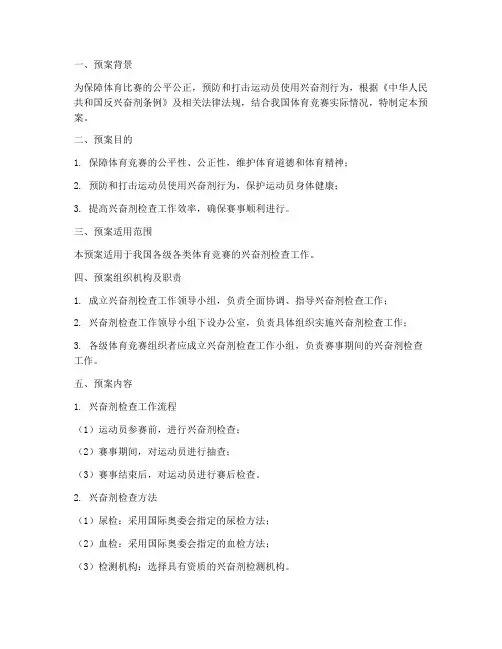
一、预案背景为保障体育比赛的公平公正,预防和打击运动员使用兴奋剂行为,根据《中华人民共和国反兴奋剂条例》及相关法律法规,结合我国体育竞赛实际情况,特制定本预案。
二、预案目的1. 保障体育竞赛的公平性、公正性,维护体育道德和体育精神;2. 预防和打击运动员使用兴奋剂行为,保护运动员身体健康;3. 提高兴奋剂检查工作效率,确保赛事顺利进行。
三、预案适用范围本预案适用于我国各级各类体育竞赛的兴奋剂检查工作。
四、预案组织机构及职责1. 成立兴奋剂检查工作领导小组,负责全面协调、指导兴奋剂检查工作;2. 兴奋剂检查工作领导小组下设办公室,负责具体组织实施兴奋剂检查工作;3. 各级体育竞赛组织者应成立兴奋剂检查工作小组,负责赛事期间的兴奋剂检查工作。
五、预案内容1. 兴奋剂检查工作流程(1)运动员参赛前,进行兴奋剂检查;(2)赛事期间,对运动员进行抽查;(3)赛事结束后,对运动员进行赛后检查。
2. 兴奋剂检查方法(1)尿检:采用国际奥委会指定的尿检方法;(2)血检:采用国际奥委会指定的血检方法;(3)检测机构:选择具有资质的兴奋剂检测机构。
3. 兴奋剂检查结果处理(1)阳性结果:立即停止运动员参赛资格,并按照《中华人民共和国反兴奋剂条例》进行处罚;(2)阴性结果:正常参赛。
4. 兴奋剂检查保密工作(1)兴奋剂检查结果仅限于兴奋剂检查工作领导小组、检测机构和赛事组织者知晓;(2)不得泄露运动员个人隐私。
六、应急预案1. 发现运动员使用兴奋剂行为,立即停止其参赛资格,并报告兴奋剂检查工作领导小组;2. 对涉嫌使用兴奋剂的运动员,进行隔离审查,确保其配合调查;3. 对涉嫌使用兴奋剂的运动员,及时通知其所属单位,并协助调查;4. 对涉嫌使用兴奋剂的运动员,根据调查结果,依法进行处罚。
七、附则1. 本预案自发布之日起实施;2. 本预案由兴奋剂检查工作领导小组负责解释;3. 本预案如与国家相关法律法规相抵触,以国家法律法规为准。
为什么比赛前要检测兴奋剂随着竞技运动的日益发展,兴奋剂成为了一些体育选手在比赛前提高自己竞技实力的途径。
但是,使用兴奋剂不仅会损害运动员自身身体健康,同时也会挑战公平竞争,所以比赛前检测兴奋剂已经成为了竞技运动必不可少的一项工作。
下面具体说明为什么要比赛前检测兴奋剂。
首先,使用兴奋剂对于运动员自身的健康问题是非常严重的。
兴奋剂在体内的加速分解和代谢,会对人的身体进行非正常的刺激,对于运动员自身的身体健康带来极大地危害。
就拿最常见的兴奋剂——激素类药物来说,使用激素类药物能够提高蛋白质合成的速度,但物质加速分解的代价是产生了大量的代谢产物,并且长期使用会对人体自身维持正常的内分泌系统带来极大的影响。
而合成血红素的药物,虽然能够提高运动员自身的血氧含量,加快高强度运动的恢复速度,但是在使用过程中会导致造血过程被破坏,严重损坏,对于健康会带来极大的危害。
因此,比赛前检测兴奋剂就可以有效地避免兴奋剂的使用,防止选手自身身体健康受到损害。
其次,使用兴奋剂会损伤比赛的公平性原则。
竞技运动的比赛原则就是平等、公正、公平,如若有个别运动员使用了兴奋剂这种非法手段,那么使用兴奋剂的运动员就会在合法运动员的艰苦训练与积累的成果上占有劣势,在彼此的竞争中会失去良心竞争的效果,并且也会违背比赛本身的公平性原则。
比赛的公平性原则对于竞技运动来说是极为重要的一个方面,也是不可替代的。
因此,比赛前检测兴奋剂能够保证比赛的公平性原则,确保比赛真正实现了公正比赛的目的。
最后,比赛前检测兴奋剂可以避免违反国际体育规则和法律法规。
从2004年开始,世界反兴奋剂机构(WADA)就开始检测运动员的使用情况,并按照国际体育机构的规定制定了运动员使用兴奋剂的规范标准。
随着时间的推移和努力,越来越多的国家和机构也开始重视运动员使用兴奋剂的问题,制定相关规定,并提倡比赛前检测兴奋剂的工作。
因此,比赛前检测兴奋剂可以避免违反国际体育规则和法律法规,使得运动员合规、公平竞争,也保障了运动员在体育赛场上的荣誉地位。
第二部分:对运动员进行兴奋剂检查的有关规定一、运动员禁用方法(一) 篡改血液和血液成分以下方法禁用:1.向循环系统内注入或回输任何来源及任何数量的自体、同源或异源血液或血红细胞制品。
2.人为提高氧气摄入、输送或释放的方法。
包括但不仅限于使用全氟化合物、乙丙昔罗【efaproxiral(RSR13)】及经修饰的血红蛋白制剂(如以血红蛋白为主剂的血液替代品,微囊血红蛋白制剂等)。
补充氧气不禁用。
3.通过物理或化学手段,以任何形式向血管内输送全血或血液成分。
(二)化学和物理篡改以下方法禁用:1.在兴奋剂检查过程中,禁止篡改或企图篡改样品的完整性和有效性的行为。
包括但不仅限于:置换尿样和/或变更尿样(例如使用蛋白酶)。
2.在6小时内,静脉输液或静脉注射剂量不得超过50ml,但在医疗机构进行的合理治疗或临床检查过程中的正当使用除外。
(三)基因兴奋剂以下具有潜在提高运动能力的手段禁用:1.改变核酸聚合物或核酸序列;2.使用常规或经基因修饰的细胞。
二、运动员兴奋剂检查项目运动员赛内检查的样本检测《兴奋剂目录》中第一部分所有的禁用物质和《兴奋剂目录》中第二部分所有的禁用物质和禁用方法。
运动员赛外检查的样本检测《兴奋剂目录》中第一部分中的除麻醉药品品种、刺激剂(含精神药品)品种、药品类易制毒化学品品种、医疗用毒性药品品种以外以及《兴奋剂目录》中第二部分除所有说明赛外不禁用的物质以外的所有禁用物质和禁用方法。
三、运动员兴奋剂检查样本中某些禁用物质的浓度上限《兴奋剂目录》所列禁用物质中,除下表所列的物质有允许尿中浓度上限,需进行定量检测,或本章中有特殊说明的物质外,其余禁用物质只要经科学方法确证尿中存在该禁用物质或其代谢物、标记物,无论浓度高低,均视为该样品含有禁用物质。
定量检测阈值物质表四、运动员治疗用药运动员确因治疗需要使用含有《兴奋剂目录》中所列物质的药物,或含有由国家体育总局规定的部分特殊项目所禁用,但不包含在《兴奋剂目录》中所列物质的药物,应向国家体育总局有关部门申请治疗用药豁免。
兴奋剂检测技术有哪些新进展在体育竞技领域,确保比赛的公平性至关重要,而兴奋剂的使用严重违背了这一原则。
为了维护体育的纯洁性和运动员的合法权益,兴奋剂检测技术不断发展和创新。
过去,兴奋剂检测主要依赖尿液样本的分析。
然而,随着科技的进步,检测手段日益多样化和精准化。
如今,血液检测成为了重要的补充方式。
血液检测能够更直接地反映运动员体内的生理指标和物质变化,对于一些新型兴奋剂和微量物质的检测具有更高的敏感性。
基因检测技术是近年来的一项重大突破。
通过对运动员基因的分析,可以发现某些与运动能力提升相关的基因变异。
这种检测方法不仅能够检测出传统的兴奋剂物质,还能揭示运动员是否通过基因编辑等手段来增强自身的运动表现。
生物标志物检测也是新的发展方向之一。
运动员在使用兴奋剂后,体内会产生一些特定的生物标志物。
例如,某些蛋白质、代谢产物的含量会发生变化。
检测这些生物标志物可以为判断是否使用兴奋剂提供有力的证据。
在检测仪器方面,高分辨率质谱仪的应用大大提高了检测的精度和准确性。
它能够分辨出极其微小的分子差异,从而更准确地识别出各种兴奋剂及其代谢产物。
同时,检测技术的发展也体现在检测时间窗口的延长上。
以往,一些兴奋剂在体内的存留时间较短,难以被检测到。
但现在的新技术能够检测出更长时间之前使用过的兴奋剂,大大增加了违规行为被发现的概率。
还有一个重要的进展是检测样本的保存和追溯技术。
为了确保检测结果的准确性和公正性,样本需要在严格的条件下保存,并且能够在需要时进行重新检测和验证。
此外,智能化的数据处理和分析系统也在兴奋剂检测中发挥了重要作用。
大量的检测数据可以通过这些系统进行快速、准确的分析,帮助检测人员发现潜在的违规迹象。
值得一提的是,兴奋剂检测技术的新进展不仅仅是在实验室检测环节。
现场快速检测技术的发展也为比赛中的即时监控提供了可能。
例如,便携式检测设备可以在比赛现场对运动员进行初步筛查,一旦发现异常,再进行更深入的实验室检测。
兴奋剂检测标准
摘要:
1.兴奋剂检测标准的概述
2.兴奋剂检测的目的和意义
3.兴奋剂检测的方法和流程
4.我国兴奋剂检测标准的现状
5.兴奋剂检测标准的未来发展趋势
正文:
兴奋剂检测标准是保障运动员在体育竞技中公平竞争的重要手段。
通过检测运动员的生物样本,判断其是否使用了违禁药物,从而确保比赛的公平性和体育精神的纯洁性。
兴奋剂检测的目的和意义主要体现在以下几个方面:
1.维护体育比赛的公平性,防止运动员通过使用违禁药物提高比赛成绩,对其他运动员造成不公平竞争。
2.保障运动员的身体健康,许多违禁药物对人体健康具有极大的危害,如心血管、肝脏等器官的损害,甚至可能导致死亡。
3.确保体育精神的纯洁性,维护体育道德,倡导健康向上的体育文化。
兴奋剂检测的方法和流程通常包括以下几个步骤:
1.收集生物样本:通常包括尿液、血液和唾液等。
2.提取分析物:从生物样本中提取需要检测的药物成分。
3.运用检测方法:包括免疫分析法、色谱分析法、质谱分析法等,对提取
的药物成分进行定性和定量分析。
4.数据分析与结果判断:将检测结果与兴奋剂名单进行比对,判断运动员是否使用了违禁药物。
我国兴奋剂检测标准不断完善,已与国际标准接轨。
我国国家体育总局反兴奋剂中心负责制定和实施兴奋剂检测政策,对我国运动员进行兴奋剂检测,并积极参与国际间的反兴奋剂合作。
未来,兴奋剂检测标准将不断发展,以应对新型违禁药物的出现。
技术进步将使检测方法更加灵敏、快速和准确,提高兴奋剂检测的效力。
兴奋剂检查英语口语兴奋剂检查是体育比赛中非常重要的一部分,以确保运动员不使用违禁药物来提高他们的表现。
以下是一些兴奋剂检查的英语口语表达:"I have been selected for doping control."(我被选中进行兴奋剂检查。
)"I will provide a urine sample for doping testing."(我将提供尿样进行兴奋剂检测。
)"I need to take a blood test for doping control."(我需要进行血液检测以进行兴奋剂检查。
)"I have been informed that I need to submit to a doping control."(我被告知需要进行兴奋剂检查。
)"I am required to take a drug test as part of the doping control process."(我需要进行药物检测作为兴奋剂检查过程的一部分。
)"I have been randomly selected for a doping test."(我被随机选中进行兴奋剂检测。
)"I need to provide a urine sample for a doping test."(我需要提供尿样进行兴奋剂检测。
)"I have been asked to take a blood test as part of the doping control process."(我被要求进行血液检测作为兴奋剂检查过程的一部分。
)"I am required to submit to a doping test at the request of the authorities."(应当局要求,我需要接受兴奋剂检测。
兴奋剂检测概述兴奋剂检测是一种通过分析和检测人体中的兴奋剂成分来判断是否使用了兴奋剂的方法。
兴奋剂是指能够提高体能、增加警觉性和抑制疲劳的药物。
在体育竞技中,兴奋剂的使用被视为不公平的行为,也是违反体育道德规范的行为之一。
因此,兴奋剂检测在体育赛事中起着重要的作用,被广泛应用。
兴奋剂的分类兴奋剂通常可以分为以下几类:1.酮煤醇:酮煤醇是目前使用最广泛的一类兴奋剂,它可以大幅度提高运动员的肌肉爆发力和肌肉耐力,从而提升运动成绩。
2.脱氢表雄酮:脱氢表雄酮是一种类固醇激素,可以刺激人体产生更多的红细胞,在提高运动员耐力的同时,也会增加心血管疾病的风险。
3.血液高能磷酸盐:血液高能磷酸盐主要用于短跑和跳远等项目中,它可以帮助肌肉迅速释放能量,提高爆发力。
4.利尿剂:利尿剂虽然不能直接提高运动成绩,但是可以掩盖其他兴奋剂的使用痕迹,从而让运动员逃避兴奋剂检测。
兴奋剂检测的方法兴奋剂检测通常包括以下几个步骤:1.尿液样本收集:通常,兴奋剂检测会采集运动员的尿液样本进行检测。
尿液样本可以提供较长的检测窗口期,并且采集过程相对简便。
2.检测方法选择:根据兴奋剂的类型和特点,选择相应的检测方法。
常见的检测方法包括质谱法、高效液相色谱法等。
3.样本分析:将收集到的尿液样本送至实验室进行分析。
实验室将运用先进的科学技术进行样本分析,以确定是否存在兴奋剂成分。
4.结果判定:根据检测结果和相关标准,判定样本是否为阳性。
阳性结果表示运动员使用了兴奋剂,将面临相应的处罚。
兴奋剂检测的局限性兴奋剂检测虽然是目前唯一可行的方法,但仍然存在一些局限性:1.检测窗口期:兴奋剂一般在尿液中停留时间较短,仅有数天甚至几小时。
因此,如果使用兴奋剂的时间距离检测较长,则可能无法检测到。
2.新型兴奋剂的发展:随着科学技术的不断进步,新型兴奋剂不断涌现。
这些新型兴奋剂可能无法被传统的检测方法所检测到。
3.误判的可能性:虽然现代的兴奋剂检测方法非常精确,但仍然存在一定的误判可能性。